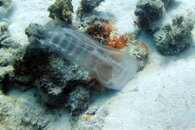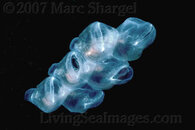glazeddonut
Registered
Hey all,
There's probably a better place on the boards to post Fish ID questions, but I saw this thing in Bonaire last week, and thought I'd check here first, to see if someone with local knowledge knew what this was.
So, what the heck is this thing? Transparent, like a jellyfish, but sort-of shaped like a fish, seemed to have something like a mouth at one end, and no apparent tentacles. Sorry for the poor photo...unfortunately the camera battery died before I could get a better pic. Saw about 4-5 of these at Something Special on one of my dives. Didn't see any others the whole trip.

There's probably a better place on the boards to post Fish ID questions, but I saw this thing in Bonaire last week, and thought I'd check here first, to see if someone with local knowledge knew what this was.
So, what the heck is this thing? Transparent, like a jellyfish, but sort-of shaped like a fish, seemed to have something like a mouth at one end, and no apparent tentacles. Sorry for the poor photo...unfortunately the camera battery died before I could get a better pic. Saw about 4-5 of these at Something Special on one of my dives. Didn't see any others the whole trip.





